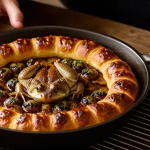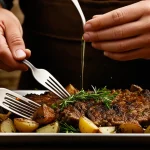Unique and Surprising Ingredients in Traditional British Recipes
Traditional British recipes often include secret British ingredients that can surprise those unfamiliar with the cuisine. For instance, dishes might feature components like suet, dried fruits such as currants, or even offal cuts, which are considerably less common in contemporary global cooking. These unique recipe components contribute distinct textures and flavors that define many classic dishes.
Many regional recipes rely on unexpected elements that reflect local resources and history. For example, the use of black pudding—a blood sausage—is a hallmark in northern regions, showcasing how ingredients derived from whole animal utilization are celebrated in British culinary traditions. Similarly, the incorporation of malt vinegar or mustard seeds highlights the inventive use of pantry staples to enhance flavor profiles.
Also read : How do you prepare a mouthwatering toad in the hole?
The origins and history behind these ingredients often link back to times when food preservation and resourcefulness were paramount. Suet, rendered beef or mutton fat, was traditionally used in puddings for its richness and ability to hold structure during cooking. Dried fruits were not only flavorful but also practical for storage through long British winters. Understanding these historical contexts enriches appreciation for the often overlooked, yet vital, ingredients in traditional British recipes.
Famous Dishes Showcasing Secret British Ingredients
When exploring classic British dishes, many feature unusual ingredients that are central to their traditional appeal. Yorkshire pudding, for example, relies on a simple batter but is often cooked with beef drippings, imparting a unique flavor that differentiates it from other batters worldwide. This secret British ingredient elevates the dish beyond its humble components.
Topic to read : What are the essential tips for a hearty shepherd’s pie?
Another iconic recipe is black pudding, which uses pig’s blood combined with oatmeal and suet. This ingredient combination may surprise those unfamiliar with British food traditions but is essential for creating its distinct texture and taste. The use of blood as a cooking element reflects a unique recipe component rooted in British culinary heritage, demonstrating resourcefulness and a connection to local livestock farming.
Stargazy pie is a less common but fascinating example, containing whole pilchards with heads protruding through the pastry crust. The inclusion of these unusual ingredients contributes both visual drama and a rich, sea-flavored depth. This dish highlights how secret British ingredients provide authenticity and regional identity, as it originates from Cornwall’s fishing communities.
These dishes not only utilize unusual ingredients but also tell a story of how traditional British recipes balance flavor, texture, and resourcefulness. Each ingredient combination serves a purpose—whether for richness, preservation, or flavor—showcasing the long history behind authentic UK recipes.
Exploring the Cultural and Historical Roots
British food history reveals a tapestry woven from diverse influences, highlighting how ingredient origins shape the culinary landscape. Many traditional British recipes stem from times when preservation and resourcefulness were vital. This historical backdrop explains the frequent use of unique recipe components like suet or dried fruits, which were practical for long storage and nutrition during harsh seasons.
Regional variations in British cuisine emphasize the importance of local environment and resources. For instance, coastal areas developed dishes incorporating seafood, such as pilchards in Stargazy pie, reflecting a tradition deeply tied to fishing communities. Inland regions often rely on meats and grains, showcasing how secret British ingredients emerged from geographical necessity.
Cultural traditions also influence the presence of certain ingredients. The use of offal or blood products in recipes like black pudding reflects not only frugality but also a respect for using the whole animal—an approach embedded in British culinary traditions. These ingredients carry stories of heritage and identity, preserved through generations and celebrated in authentic UK recipes.
Understanding the historical and cultural context of these components enriches the appreciation of British cuisine. It reveals how traditional British recipes are more than just food—they are a reflection of a nation’s history, environment, and values expressed through its secret British ingredients.
Tips for Recreating Authentic British Flavours at Home
When aiming to recreate traditional British recipes in your own kitchen, accessing some secret British ingredients can be challenging but rewarding. Many unique recipe components, like suet or black pudding, are often not readily available abroad. However, there are practical substitutions and techniques to help capture authentic British flavors.
For example, suet—a key ingredient for many puddings—can be substituted with shredded cold butter combined with a small amount of vegetable shortening if beef or mutton fat is unavailable. This maintains the rich texture essential in dishes like spotted dick or Christmas pudding. Similarly, black pudding’s distinctive texture and depth come from pig’s blood and oatmeal, which can be approximated using rich pork sausages combined with finely ground oats for an experimental alternative.
To enhance flavors reminiscent of classic British kitchens, try incorporating malt vinegar or English mustard seeds, which are more commonly found in international supermarkets. These ingredients add that unmistakable tang or spice that elevates a dish beyond simple seasoning. When fresh offal or less familiar cuts are hard to source, organ meat-based pâtés or similar products can occasionally stand in to honor authentic flavors.
Beyond ingredient substitutions, expert British cooking tips emphasize technique and timing. Traditional methods, such as slow simmering stews or carefully controlled baking, are vital to replicate the textures and depth of flavor unique to British dishes. Using quality, fresh ingredients and respecting original proportions help ensure the end result reflects authentic British cuisine.
By combining thoughtful ingredient choices with classic cooking approaches, home chefs can successfully recreate traditional recipes, celebrating the unique recipe components that define British food culture. This not only preserves culinary heritage but also provides an enjoyable, educational experience exploring the richness of British gastronomy.








